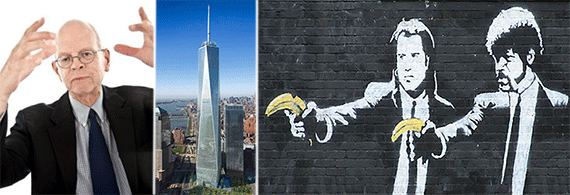Trending
What’s Banksy’s problem with 1 World Trade Center?: Architecture review

By now it is safe to assume that all of you know about Banksy, the savvy British graffiti artist-cum-publicity hound who has managed to work himself into the news cycle every day for the past month. This is not the place to comment upon his art, other than to say that it is slightly better than mediocre, slightly better than most graffiti art, slightly better than much of what one sees in Chelsea these days, and yet, ultimately, not quite good enough.
Rather, I would draw your attention to his depreciative assessment of One World Trade Center. His remarks appeared in a piece he published on his website — after the New York Times rejected it for its op-ed page. (And you can just imagine this artist — who chooses anonymity precisely to win himself even more attention — salivating at the coup of landing his screed in the Times, thus crowning a month of truly astonishing self-promotion.)
Banksy does not spell out why he dislikes the nearly completed tower other than to say that it “lacks any self-confidence. How does it stand up without a spine? … One World Trade declares the glory days of New York are gone … a one thousand foot tall sign that reads — New York — we lost our nerve.”
But in consuming Banksy’s critique of the building — designed by David Childs of Skidmore Owings and Merrill as a variant upon Daniel Libeskind’s original design — one must read between the lines.
There, one understands what Banksy is really saying: the building is symmetrical. To those who think that deconstructivist architecture is still at the cutting edge, who do not realize that it has been descending into a period style for the past decade, that it has become the default style of corporate America and beyond, the punctilious symmetry of 1 World Trade Center is apt to seem like an affront.
In fact, it is a largely successful effort from the folks over at SOM. Surely it will not redefine the skyscraper in the way in which, one could argue, Norman Foster’s Gherkin Building and Renzo Piano’s Shard of Glass have done in Banksy’s hometown of London. Given the new and global importance of the site, however, anything too clamorously trendy would have seemed like a sacrilege. The calm symmetry of the building answers to exactly what the site calls for.
And as for Banksy’s claim that New York has lost its nerve, it is quite clear that he has not spent much time around here over the past few centuries. While New York has shown daring with regard to engineering, architecturally speaking
— with a few modernist exceptions during the middle of the last century — the city has always erred on the side of conservatism. Sometimes this inclination turns out better than it does on other occasions.
At 1 World Trade Center, it has turned out well enough.




